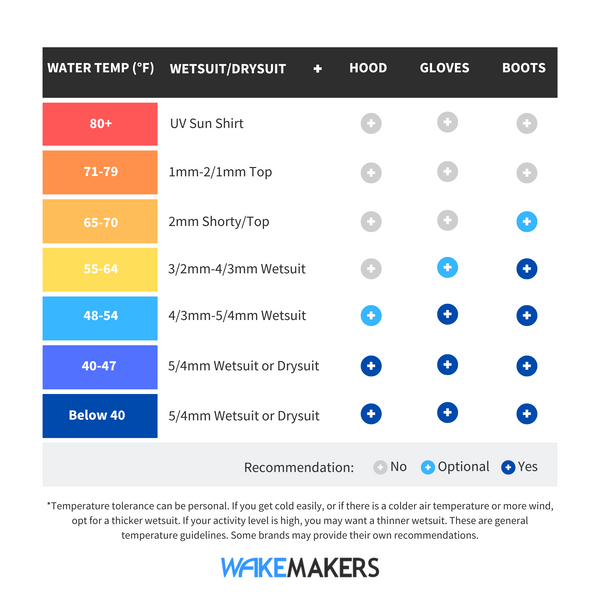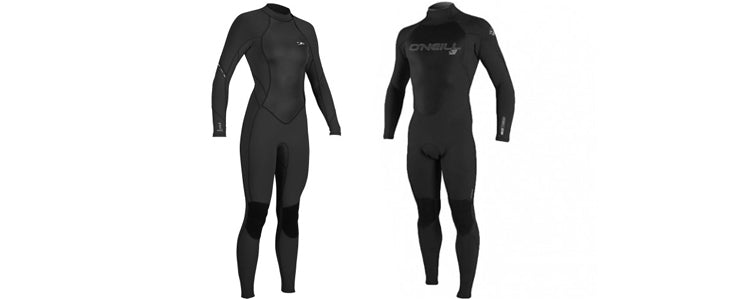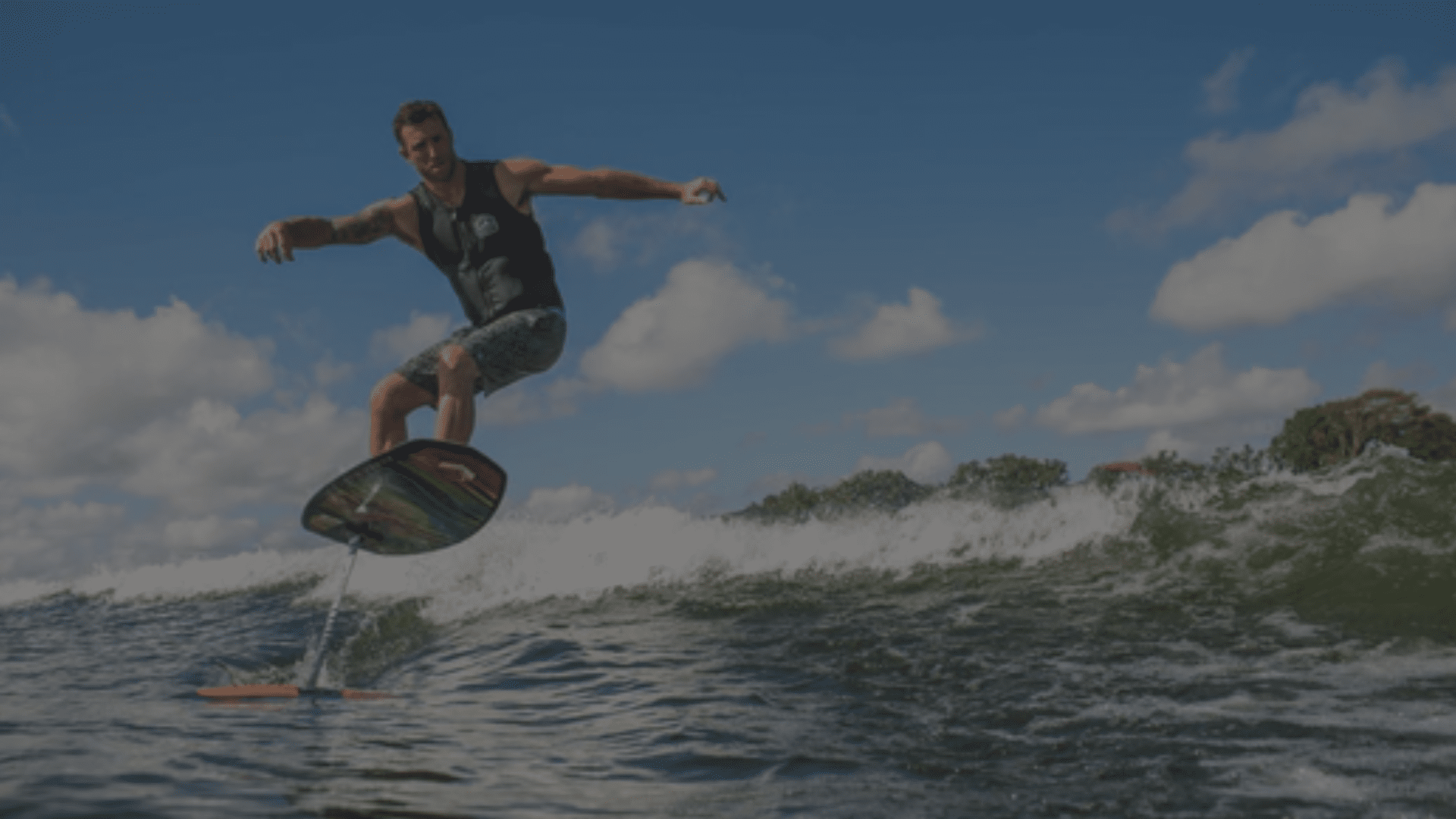
Wetsuit Buyer's Guide
Everyone enjoys riding on a hot summer day but, alas, the season only lasts so long. Whether you are starting your season early or looking to extend it even once summer is long gone, getting the correct gear is vital to making cold water riding an enjoyable experience. In fact, some of the best days riding at the lake are during the spring and fall. Most of the time the sun is shining, no other boats are out and the water is glass. Time to get suited up and ready to rip!
This WakeMAKERS Buyer's Guide will help get you all dialed in with the right gear for enjoyable cold water riding.
Just How Cold Is The Water?
The first step to getting the correct cold water gear is to identify the temperature of the water where you are riding.

Use the cold water chart provided above to find out your recommended cold water setup based on water temp.
Other Factors to Consider
Water temp isn't the only factor to consider though. Other variables such as outside temperature, wind, preferred comfort level, and desired range of motion are important to consider. Some people prefer to feel super warm like they are in a boat while others just need enough warmth to not be shivering in the water. At the end of the day it is all about your personal desired level of warmth and comfort. After all, if you are cold, you won't be having fun.
There is no perfect equation to find the right gear. For example, you might go out and ride in 60 degree water and decide to wear a full wetsuit whereas your buddy opts to wear a drysuit instead. Nothing wrong with either choice.
Now that we've gone through what gear you'll need, we'll now go into more details about each of those products.
Wetsuits | The Go-To Option for Cold Water Riding
A wetsuit is the most popular choice in cold water. Once you decide to go the wetsuit route, there are lots of options to consider. We'll explain all that fun stuff so that you become a wetsuit expert by the time you are done reading.
How Do Wetsuits Keep You Warm?
Everyone knows that wetsuits help keep you warm but most people don't know exactly how a wetsuit works.
Wetsuits are designed to keep you warm by trapping a small layer of water between your body and the suit's neoprene material. This thin layer of water is heated up by your body temperature and in turn it keeps you warm while you are wakeboarding or wakesurfing. Peeing in your wetsuit also heats it up (not recommended though).
Choosing The Right Size Wetsuit
Now that you know how a wetsuit works you can understand why it is so important to have a proper fitting wetsuit. In order for the wetsuit to perform correctly it needs to be snug to your skin. If it is too loose it will not keep you warm properly due to the excess cold water that flushes into the suit. There is such thing as too tight. In this case it can become very uncomfortable as it limits your range of motion and can cut off circulation to your hands and feet.
When you are buying a wetsuit online it's important to closely look at the sizing charts, measure yourself, and find out which size will be the best fit for you. O'Neill wetsuits fit true to size, so make sure you get an accurate measurement. Your wetsuit should fit like a second skin. There shouldn't be any excess room in the legs, arms, or chest area. A wetsuit should also fit snuggly around your neck so there isn't any room for cold water to seep in.
Men's Wetsuit Size Chart
Use the O'Neill size chart below. Measure your height, your waist, and chest. Note: If in-between sizes, go up.

Women's Wetsuit Size Chart
Use the O'Neill size chart below. Measure your height, chest, and hips. Note: If in-between sizes, go up.

Wetsuit Thickness
When shopping for wetsuits, you will notice there are two numbers listed for each suit. These numbers are very important as they are the thickness rating. The larger number stands for the thickness (mm) in the body and the smaller number is for the extremities (arms legs). The reason for the difference in wetsuit thickness is that you need more movement in your arms and legs so the material on your extremities is thinner and therefore more stretchy.
For water sports use, almost everyone wears a 3/2 wetsuit. Many surfers and scuba divers wear thicker wetsuits such as a 4/3 or even a 5/4. They are typically in colder water though and out there for longer durations of time, therefore needing more warmth. For wakeboarding, wakesurfing, and waterskiing, a 3/2 wetsuit will keep you plenty warm.
The general rule of thumb is the thicker the wetsuit, the warmer it will keep you. If you haven't bought a new wetsuit recently, you'll be amazed how well they work. A new 3/2 wetsuit will keep you much warmer than a 4/3 that you've had for years now.
However, other factors such as the overall quality of the neoprene, seals, seams, etc. will also play a factor in the wetsuits overall warmth. New technology from O'Neill like their FuzeFlex Firewall and TechnoButter have helped their wetsuits move forward leaps and bounds as far as warmth and comfortability.
Seams & Seals
The seams and seals play a large role in how warm the wetsuit will be. If you are riding in colder water temperatures, you will want to carefully consider these features ensure the areas around your neck and limb don't allow in water.
Flatlock stitchingFlatlock stitching involves laying one neoprene panel edge over the other and then stitching them together. Because this creates a lot of small holes it's recommended for water over 60 degrees. The stitching holes will allow some water making it a better option for Spring/Summer suits.
Glued and blind stitchedGlued and blind stitched wetsuits are the next step up from flatlock seams. These suits are glued and then stitched leaving almost no room for water to come through. They are recommended for water temperatures over 55 degrees.
Glued blind stitched and 100% tapedThese suits offer you the ultimate seal. 100% waterproof, the glued blind stitch and taped seams apply a special liquid rubber to the inside seam for the warmest possible wetsuit. This technology is often found in cold water and high-end wetsuits. Don't get confused if you see it called something else because each manufacturer has their own name for glued and taped seams but they essentially function the same way.
Zipper Types
Back ZipperMost of the wetsuits we carry feature back zippers. These are easier to get in and out of than chest zip wetsuits, but the don't offer as much flexibility because the larger back zipper can restrict some of your movement in the water.
Chest ZipperChest zip wetsuits are a newer technology that was developed as a more flexible and more waterproof solution. The smaller zipper on the chest wetsuit allows less water to come through. These wetsuits are tougher to get in/out of.
Neoprene Material Types
Entry LevelThese suits are often called standard stretch and they are the least flexible and warm wetsuits. These suits are generally at a lower price point and sufficient enough for consumers who aren't in their wetsuits very often.
Mid-LevelThese suits are called super-stretch and they feature a higher quality neoprene that has more air impregnated in the layers. This creates a better flexing and warmer wetsuit that's generally at a higher price point.
High-End and Eco WetsuitsThese wetsuits are made from the highest quality materials and the latest in neoprene technology. If you are looking for the ultimate in performance and comfort, these suits will do the trick. Some companies are manufacturing Eco friendly wetsuits made from recycled neoprene materials if you are interested in reducing your carbon footprint while you stay warm in the water.
Wetsuit Styles
Full

Full wetsuits are designed to be the warmest wetsuits because they cover your entire body except for your head, feet, and hands. We recommend using full wetsuits in 55-70 degree water (or on those brisk early morning sets).
Spring
Designed for use in warmer water, typically 68+ degree water. There are may different styles of spring suits including short-sleeves, long johns, shorty suits (wetsuit with short sleeves and shorts) and neo shorts. Primarily used to keep your body core warm. Offers added mobility.
Neo Top
Neo tops can be used in 70+ degree water to add some extra warmth. Great for early morning rides as well.
Rash Guards
Rash guards do not provide much added warmth. Instead, they are designed to help protect your skin from the sun and harmful uv rays. Also help to prevent rashes and chaffing. A good option if you are going to be in the sun all day.
Wetsuit Accessories
Often overlooked, neo accessories are equally important when it comes to cold water riding. If not protected from the elements, Your body might be totally warm, but if your hands and/or feet are freezing cold you are going to have a hard time riding, let alone enjoying it. This next section will cover the needed accessories to go with your wetsuit.
Booties

We recommend neo boots (commonly called booties) for wake surfing in cold water. They keep your feet warmer and still give you the needed grip with your board thanks to the rubber sole. Neo boots vary in thickness from 1mm to 7mm+. For wakesurfing we recommend a thinner boat ranging from 1-3mm, keep you warm while providing ample feel and control between your feet and the board. For wakeboarding, you won't need a pair of booties since your feet will be inside the bindings. However, some wear a neo sock (no sole) that they put on before their bindings.
Gloves

Gloves are another recommended accessory for cold water wakesurfing or wakeboarding. If you are sensitive to the cold, neoprene gloves are a must. After all, it is very difficult to hold onto the handle if you can't feel your hands.
Hoods
Wearing a hood in cold water is just as important as wearing a beanie while at the mountain. In fact, you can lose up to 40% of your heat through your head if left exposed to the cold. Save yourself from a brain freeze, throw on a hood.
Got some questions that still need answered? Don't worry, our team of product experts are available. Give us a call.





Post Comments
0 Item(s)